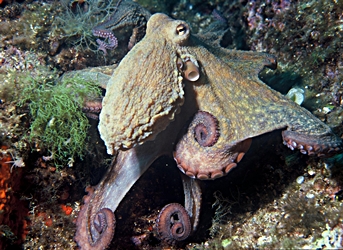
Common octopus (Octopus vulgaris). Picture: Albert Kok, Wikipedia.
 Common octopus (Octopus vulgaris). Picture: Albert Kok, Wikipedia. |
With their eight arms octopuses can achieve astounding things. That is especially remarkable, when an octopus' arm has been separated from its body. That can happen quite often, when octopuses are attacked by their enemies. Some squids even separate their arm on purpose. The argonaut, related to the octopus, during mating uses a hectocotylus, like other octopuses do. Unlike other octopuses, however, the argonaut separates the hectocotylus and pushes it towards the female. Female squids often eating the smaller males this may be wise. Anyway the hectocotylus usually finds its way alone. When the hectocotylus once was found inside a female argonaut by a biologist it was described as an own species of worms because it was not understood, how a separated arm could serve an octopus.
Research at the Jerusalem university has shown, that cut off octopus' tentacles are able to keep moving afterwards, as if they still were connected to the brain. Scientists have explained this by locomotion patterns stored in the arms, separate from the brain. The high content of nerve cells inside octopus arms seems to be a hint in this direction. An octopuses arm contains about 50 million neurons, only 400,000 of which serve muscle control. The others belong to a very powerful peripheral nervous system.
When a movement order is given from the brain to the arm, this order obeyed autonomously by the arm's neurons following the stored locomotion patterns.
This ability make the octopus' arm and that of other squids interesting not only to biologists, but also to robot specialists. The human body is not the best example for a robot as it has much to few joints and thus is by far not flexible enough.
Reference:
Geo Explorer: Eight arms help thinking ... (12/2001)